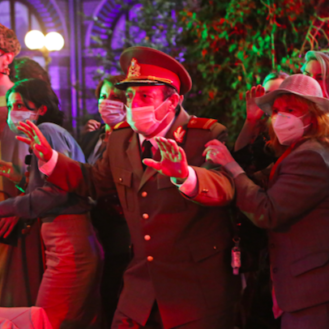By: Mark Barber
Prolific documentarian Alex Gibney’s latest film is an insightful–if perhaps overlong–two-hour reminder of the controversial Church of Scientology. Based on and working extensively off of Lawrence Wright’s 2013 book Going Clear: Scientology, Hollywood, and the Prison of Belief, Gibney traces Scientology’s history from its very beginnings with its erratic and odd founder L. Ron Hubbard to the assimilation of Hollywood celebrities into the cult.
Perhaps most distressingly, however, is Gibney’s chosen slate of interviewees: including Wright himself, several of Gibney’s subjects are both former celebrity members (including Academy Award-winning filmmaker Paul Haggis, director of 2006’s Crash, whose diatribe against the Church’s opposition to same-sex marriage was well-documented in the media) and former high-ranking executive members.
Going Clear’s greatest strengths are Gibney’s intelligent editing and thorough research. Gibney’s editing is brilliantly dialectical: a number of his subjects are situated in dialogue with themselves in archival footage. In general, Gibney makes maximum use of the documentary form: Going Clear uses a mix of re-enactment, found footage/collage, and self-reflexive, cinéma vérité-style interviews.
Both Gibney and Wright have done their research, and it shows. Going Clear brings to light a number of devastating truths about the Church. Beginning with a brief but critical summary of the hallucinatory paranoia of L. Ron Hubbard, the film moves towards the Church’s current state of affairs under the leadership of the discomfortingly charismatic David Miscavige, who has been accused of physically abusing Church members and harassing and surveying ex-members. Many of Gibney’s interviewees–many of whom are former Church executives themselves–illuminate Miscavige’s disturbing manipulative control over members.
Although Scientology is perhaps thought of as “the Hollywood cult,” that aspect of the Church feels like a distraction from the more disturbing facets of the film’s argument. John Travolta and Tom Cruise’s fanatical participation in the religion has been well-documented, and it only makes sense for Gibney to articulate what that means exactly in the context of both their careers and their devotion to Scientology. However, both stories feel unsuccessfully stitched in the middle of far more interesting points. Although some compelling aspects of their personal lives are revealed (including Tom Cruise’s ostensibly fabricated relationship with Nazanin Boniadi), the film’s argument is already loaded and not exactly economical to the film’s bloated running time.
Perhaps we didn’t need a 2-hour documentary on the evils of Scientology, but Going Clear is a visceral, poignant retaliation against the cult’s psychologically harmful activities.




Leave a comment